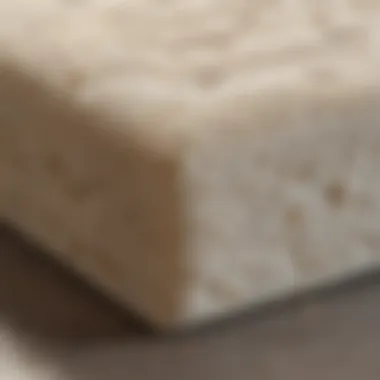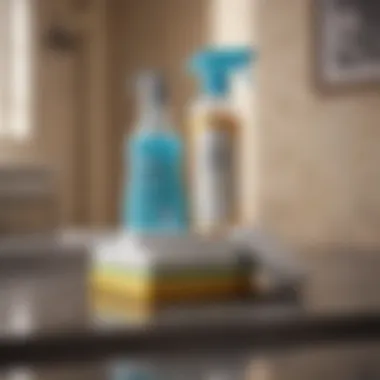Effective Ways to Clean Stains from Memory Foam


Intro
Memory foam mattresses are favored for their comfort and support, but they also face challenges related to cleanliness. Stains can mar their surface, affecting both appearance and hygiene. Homeowners often find it hard to keep these mattresses in pristine condition. This guide aims to assist in effectively addressing the issue of stains on memory foam.
In this article, we will explore various types of stains that commonly affect memory foam mattresses, including liquid spills, sweat, and dust mites. Additionally, we will provide you with a detailed list of materials needed for effective cleaning, along with step-by-step instructions for various cleaning methods. Our goal is to help extend the lifespan of your mattress through proper care tailored specifically for these delicate surfaces. Lastly, we will include preventive strategies to mitigate future staining issues.
Prelude to Memory Foam Mattresses
Memory foam mattresses have gained popularity for their unique ability to conform to the body's shape, providing personalized comfort and support. They are known for their pressure-relieving properties, which can lead to improved sleep quality and a reduction in pain for many users. The contouring nature of memory foam also makes it ideal for various sleep positions, whether you are a side, back, or stomach sleeper. This adaptability can enhance the overall sleeping experience.
However, despite their many benefits, memory foam mattresses are not impervious to stains. Understanding the materials and the reasons for stains is crucial for maintaining the longevity and cleanliness of these mattresses. Given the investment often made in such products, stain prevention and treatment become important aspects of mattress care.
Understanding Memory Foam
Memory foam is a viscoelastic material created from polyurethane foam. Originally developed by NASA in the 1960s, its ability to absorb pressure and conform to the shape of the body soon caught the attention of the bedding industry. Memory foam mattresses are designed to distribute body weight evenly, minimizing pressure points that can lead to discomfort.
The structure of memory foam contains millions of open cells that react to heat and pressure. This material becomes softer in warm areas, allowing it to mold to the body. When you move, these cells quickly recover, returning to their original shape. This feature not only offers comfort but also provides quality support for the spine.
Additionally, memory foam is often infused with gel or other additives to enhance its cooling properties. This is important to prevent heat retention, a common complaint among those who sleep on traditional foam mattresses.
Why Stains Occur
Stains on memory foam mattresses can arise from various sources, ranging from biological substances like sweat and bodily fluids to external spills like food and beverages. Understanding why these stains occur can inform owners on how to handle them properly.
Biological stains often result from typical nightly activities. Sweat is one of the primary culprits, especially for those who tend to sleep hot. Aside from sweat, any bodily fluid can potentially stain a mattress. The porous nature of memory foam can make it more vulnerable to absorbing these liquids, leading to tougher stains over time.
Food and beverage stains, on the other hand, generally happen during activities such as eating in bed or careless handling of drinks. Even minor accidents can create lasting marks if not addressed promptly.
Ink and dye stains can be trickier. They can originate from pens, markers, or even certain fabrics. When these substances come in contact with memory foam, they can seep into the material, leading to difficult-to-remove blemishes.
Being aware of these sources can aid in the proactive measures taken for cleaning and prevention, ultimately preserving the integrity and aesthetic of the mattress.
Identifying Types of Stains
Identifying the type of stain on a memory foam mattress is a crucial first step in the cleaning process. Each stain type demands specific treatment methods. Recognizing stains helps homeowners prevent damage to the mattress and maintain its lifespan. Additionally, understanding stain characteristics may save time and enhance cleaning efficiency.
Biological Stains
Biological stains typically come from bodily fluids, such as sweat or urine. These stains can be particularly challenging. They not only appear unsightly but may also emit odors if left untreated. Commonly, these stains occur from pets or accidents, especially in households with young children.
To mitigate these stains, acting quickly is essential. For instance, using an enzymatic cleaner could effectively break down the organic matter. It's important to follow the cleaner's instructions for best results. Regular inspection can help you identify and treat stains promptly before they set in deeply.
Food and Beverage Stains


Food and beverage stains can arise from everyday activities, such as snacking in bed or sipping drinks. These stains may vary in color and consistency, depending on the item causing the mark. For example, coffee and red wine are notorious for leaving dark, lasting stains.
Cleaning these stains requires an appropriate approach. Usually, a mixture of mild dish soap and water can help lift the stains. Applying the solution with a soft cloth gives a gentle, effective cleaning method. It’s essential to blot, not rub, as this could push the stain deeper into the mattress fibers.
Ink and Dye Stains
Ink and dye stains present a unique challenge. These stains often originate from pens or dyes from clothing. They can be particularly stubborn and may require specific treatments. The dye may interact with the foam material, making removal difficult.
For these stains, a rubbing alcohol treatment may prove beneficial. Apply a small amount with a cotton ball to gently remove the ink. Avoid saturating the area to prevent damage to the foam. This method requires caution and patience, as rushing may worsen the stain.
"Identifying the type of stain is key to effectively tackling the cleaning process, ensuring that the chosen method is both appropriate and safe for the mattress."
Tools and Materials for Cleaning
In the quest to maintain the cleanliness of memory foam mattresses, the right tools and materials are essential. These elements not only aid in removing stains effectively but also help preserve the integrity of the mattress over time. Utilizing proper cleaning solutions minimizes damage to the foam, ensuring its longevity. Furthermore, the right equipment streamlines the cleaning process. This section discusses specific cleaning solutions and necessary equipment.
Recommended Cleaning Solutions
Vinegar
Vinegar is a versatile solution often used in cleaning due to its acidity. This property enables it to break down stains and odors effectively. It is a popular choice for natural cleaning because it is non-toxic and safe for most fabrics. When applied properly, vinegar helps neutralize unpleasant smells that may persist in memory foam. Additionally, the cost-effectiveness of vinegar makes it an appealing option for those looking to maintain their mattress without spending heavily on specialized cleaners. However, some individuals may find the smell of vinegar off-putting. It dissipates quickly but can be strong during application.
Baking Soda
Baking soda is another effective cleaning agent praised for its deodorizing properties. It is commonly used to tackle stains while being gentle enough not to harm memory foam. The key characteristic of baking soda is its ability to absorb moisture and odors, which makes it suitable for treating sweat or food stains. A unique feature of baking soda is its ease of use; it can be sprinkled directly onto the mattress and vacuumed later. However, while it works well for surface stains, more severe discolorations may require additional cleaning methods.
Dish Soap
Dish soap stands out as an effective cleaning solution, particularly for oily or greasy stains. It is formulated to cut through fats and residues, making it a beneficial option for mattresses that have been subjected to spills or biological stains. The property that makes dish soap effective is its surfactant content, which breaks down tough stains. While it is safe for most surfaces, it is important to dilute it properly. Using too much soap can lead to residue left behind, potentially attracting more dirt after cleaning.
Necessary Cleaning Equipment
Soft Cloths
Soft cloths are imperative in the cleaning process as they avoid damaging the delicate surface of memory foam. Their microfiber material is particularly effective in lifting stains without scratching. These cloths are ideal for applying cleaners like vinegar or baking soda effectively. One benefit is their reusability; they can be washed and dried for multiple uses. However, it is important to ensure that the cloths are completely dry before use to avoid introducing excess moisture to the mattress.
Spray Bottles
Spray bottles are crucial for applying cleaning solutions evenly across the mattress surface. They allow for controlled application, minimizing the amount of cleaner used. This is particularly useful when working with liquid cleaners like vinegar or dish soap. A key advantage of using a spray bottle is the ability to mist the surface lightly, which avoids oversaturation that can damage foam. However, maintaining the bottle is necessary to prevent clogging or leaking when not in use.
Vacuum Cleaner
A vacuum cleaner designed for upholstery is another essential tool. It helps remove dust, dirt, and debris before and after cleaning. The key characteristic of a vacuum cleaner is its ability to reach into the fibers of the mattress, lifting particles that may not be visible. Using a vacuum not only prepares the mattress for a deeper clean but also maintains it on a longer-term basis. Though powerful vacuums are effective, care should be taken to avoid excessive suction, which could potentially harm the padding of the mattress.
Regularly maintaining a clean environment for your memory foam mattress is essential for its performance and longevity.


Step-by-Step Cleaning Instructions
Cleaning a memory foam mattress requires systematic approach. Each step contributes to the effectiveness of stain removal. First, thorough preparation is critical. Then, addressing stains specifically helps ensure proper treatment. Following that, drying and restoring the mattress is crucial for its longevity.
Preparing the Mattress
Removing Bed Linens
Removing bed linens is the first step in the cleaning process. This action allows for direct access to the mattress surface. It is also essential for preventing the transfer of any cleaning solutions onto the linens. By removing beddings, you can inspect the mattress for stains more clearly. It is a beneficial choice because it promotes a more thorough cleaning. Solving hidden issues is easier when the surface is bare. Take care when storing the linens to avoid wrinkling or damage.
Vacuuming the Surface
Vacuuming the surface is a necessary step before applying any cleaning solution. This process removes dust and loose debris that can interfere with direct stain cleaning. The key characteristic of vacuuming is its ability to quickly assess the mattress condition. It is popular among homeowners as it often requires minimal equipment. A vacuum cleaner with an upholstery attachment works best for this task. This tool can reach the edges and corners effectively. Remember, a clean surface is essential for effective stain treatment.
Addressing Specific Stains
Cleaning Biological Stains
Cleaning biological stains, such as sweat or bodily fluids, is integral to maintaining mattress hygiene. Biological stains can harbor odors and bacteria. A beneficial approach includes utilizing natural solutions like vinegar or baking soda. These substances neutralize unpleasant smells and sanitize the area. The unique feature of this method is its effectiveness without harsh chemicals. However, it may require several applications for tougher stains.
Removing Food and Beverage Stains
Removing food and beverage stains promptly is key in retaining mattress quality. These stains can easily set into the foam material, complicating future cleaning. A mixture of dish soap and water works well for this purpose. The benefit lies in the mild nature of the soap, making it safe for memory foam. The challenge is ensuring no excess moisture remains after cleaning, as this can affect the mattress’s integrity.
Treating Ink and Dye Stains
Treating ink and dye stains can be tricky but is essential for restoring mattress appearance. These stains often require specialized cleaning agents. Rubbing alcohol or commercial stain removers designed for fabric can be effective. Their key characteristic is their ability to break down colored substances quickly. However, caution is necessary to avoid damage to the mattress fabric. Testing any solution in a small area first is advisable to prevent unwanted discoloration.
Drying and Restoring the Mattress
Air Drying Techniques
Air drying is the preferred method to ensure a memory foam mattress maintains its shape. This process allows moisture to evaporate fully, which is crucial to prevent mold growth. The key characteristic of air drying is its non-invasive nature, as it doesn’t apply heat. Placing the mattress in a room with good air circulation is beneficial. The advantage is that this method also helps to refresh and rejuvenate the foam.
Reapplying Protective Covers
Reapplying protective covers after cleaning is a key step in mattress maintenance. These covers guard against future stains and spills. They act as a barrier, prolonging the mattress lifespan. The unique feature of using a protective cover is its ability to be washed easily, unlike the mattress itself. Regular use of these covers is a wise choice for any homeowner. It significantly reduces the need for frequent deep cleaning.
Preventative Measures Against Stains
Maintaining a memory foam mattress in pristine condition is essential for longevity and comfort. Stains, whether from spills, biological sources, or dirt, can significantly affect both aesthetics and hygiene. Preventative measures play a crucial role in minimizing these risks. They not only protect the mattress from staining but also make cleaning a lot easier when accidents happen.
Using Mattress Protectors


Mattress protectors serve as a frontline defense against stains. A high-quality protector can safeguard against spillages, body oils, and allergens. Choosing a waterproof option is beneficial as it prevents liquids from penetrating the memory foam. This will prevent odors and potential mold growth, which can be harmful to health.
Beyond stain protection, mattress protectors are easy to clean. Most are machine washable, allowing for regular maintenance without much effort. This simple step can extend the life of your mattress significantly. It is wise to invest in a protector designed specifically for memory foam mattresses since they often have specific dimensions and elastic depths, ensuring a secure fit.
Regular Maintenance Tips
Regular maintenance is key to keeping stains at bay and maintaining the mattress's integrity. Here are some effective strategies:
- Frequent Rotation: Rotate the mattress every three months. This avoids uneven wear and prolongs its lifespan. It helps in maintaining an even surface and minimizes depressions that could lead to moisture accumulation.
- Spot Cleaning: Address stains immediately. Lightly dab the stain with a cloth and a mixture of mild soap and water instead of saturating the area. This limits moisture exposure to the foam.
- Vacuuming: Use a vacuum cleaner with an upholstery attachment to regularly remove dust and debris. This helps in avoiding allergens, which can contribute to liquid stains over time.
- Avoid Strong Chemicals: Do not use harsh cleaning products, as they may damage the material. Stick to natural solutions like vinegar or baking soda, as they are safe alternatives for routine cleaning.
Remember: "An ounce of prevention is worth a pound of cure." Incorporating these measures into your routine will go a long way in maintaining the appearance and hygiene of your memory foam mattress.
Long-term Care for Memory Foam Mattresses
Taking care of memory foam mattresses is essential for maintaining their quality and longevity. Proper long-term care can not only enhance comfort but also contribute to a healthy sleeping environment. Memory foam is sensitive to various factors, such as body weight, humidity, and temperature. Therefore, understanding how to properly care for these mattresses is crucial for every homeowner.
Proper Rotation Techniques
Rotating a memory foam mattress can help in even wear and tear. Many mattress manufacturers recommend rotating the mattress every three to six months. This technique aids in preventing sagging in one area and promotes a uniform sleeping surface. Here are some key points to consider:
- Rotate head to foot: This simple technique involves flipping the mattress so that the head side becomes the foot side. It helps distribute body weight more evenly.
- Be cautious: Handle memory foam mattresses gently while rotating. Its unique material can be sensitive, so avoid folding or stepping on the edges.
By integrating this rotation into your routine, you encourage the mattress to maintain its supportive properties over time.
Cleaning Frequency Guidelines
Regular cleaning is a vital aspect of long-term care for memory foam mattresses. Dust mites, allergens, and stains can accumulate, affecting both hygiene and comfort. Here are effective guidelines:
- Monthly vacuuming: Use a vacuum cleaner with a soft brush attachment to remove dust and debris. This should be done monthly to maintain cleanliness.
- Address stains immediately: When encountered, address stains as soon as possible. The longer they sit, the more difficult they become to remove.
- Deep cleaning every six months: In addition to routine maintenance, perform a deep cleaning every six months. This might include light scrubbing with a suitable cleaning solution.
"A clean mattress is essential for a healthy sleep environment. Regular maintenance not only keeps your mattress looking good but also prolongs its lifespan."
By following these cleaning frequency guidelines, you ensure that your memory foam mattress remains fresh and inviting for years to come.
Closure
In this article, we have explored the essential aspects of caring for memory foam mattresses, focusing on stain removal and preventive measures. Understanding how stains occur and identifying their types is crucial in determining the most effective cleaning method. Stains, if not addressed properly, can lead to unpleasant odors and deteriorate the material over time.
Summarizing Key Points
We covered several significant points:
- Types of Stains: Biological stains require different attention compared to food and beverage stains. Knowing the categories is vital for effective treatment.
- Cleaning Tools and Solutions: Utilizing basic home ingredients like vinegar and baking soda can significantly enhance your cleaning efforts.
- Step-by-Step Instructions: We provided a clear approach to preparing the mattress, addressing specific stains, and ensuring proper drying afterwards. Following these steps can yield favorable results.
- Prevention and Care: Implementing mattress protectors and engaging in regular maintenance are crucial strategies for avoiding future stains.
These elements combine to create a comprehensive strategy for maintaining a memory foam mattress.
Final Thoughts on Mattress Care
Caring for a memory foam mattress goes beyond occasional cleaning. It involves consistent attention and understanding of its material properties. Regular cleaning not only removes stains but also extends the lifespan of the mattress.
Investing time in proper care is beneficial. This attention to detail ensures a comfortable sleep environment. Consider the cleaning recommendations and preventative measures provided. They contribute significantly to maintaining quality and hygiene. Remember, a well-kept mattress offers better support and comfort, enhancing overall sleep quality.















